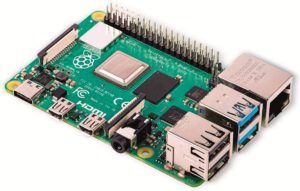What that is it ?

Night Sky Live
Always looking for new projects, I remembered that the year before, I bought a raspberryPI4 that I used not much, even not at all.
For those who do not know what a RaspberryPI is, it is a mini-computer the size of a mobile phone, which can be connected to a screen or which is accessible remotely, and use as a standard computer. Small in size - 85.60 mm × 53.98 mm × 17 mm - and in price - it can be found at around forty euros today, making it an ideal product for testing small connected IT projects. The operating system is Linux (therefore lighter than Windows or OSX). The performance is not as good as a real computer, although I know Windows PCs that are slower than the RaspberryPI.

At the same time, I matured and nurtured the project - a bit crazy for my entourage - to install in the Norman family home, a fixed observatory of astronomical observation, automated if possible, to avoid having to take out all my equipment at each visit on weekends, and above all to be able to access it remotely from Paris on sunny days.
This project, if one day it borns, requires having an eye on the sky to know the visibility announced and if launching a photo session is playable or not. Existing weather sites for astro-photographers are quite reliable - for example that of https://www.meteoblue.com/ - but never as good as a human presence in situ.
As I wander on the site selling astronomy equipment all the time, I spotted this sky observation module, connected and in real time but at more than a thousand euros. The idea was interesting but unaffordable.

And the link with the Raspberry has arrived: why not use it to connect my first guide camera which had been replaced a long time ago by a better one, and make it a small station just to see the sky?
Google is your friend, I quickly found myself on the site of Thomas Jacquin, French expatriate in Canada, who had the same idea long before me. His "AllSky" project was exactly what I wanted to do. Install software on a RaspberryPI that would acquire pictures in real time, make a timelapse of these images every night, a StarTrail and a Keogram.
As I have time on my hands and much motivation, I am off to reinstall Raspbian - Linux operating system - on my RaspberryPI, and the sources of AllSky by Thomas Jacquin.
After two days of settings (the beast is also not that easy to tame), the station was operating on "In-door" mode, meaning in my office, filming my head. It was then necessary to show a little imagination, and especially to find in the garage of Grand-Ma', the necessary material for the realization of the diagram on the left, into reality.

An old 100mm PVC toilet tube, a cut wooden board, a cut plastic plug, brackets and rusty screws and "Voilà !". Amazon helped me a lot (I know, I'm ashamed, but how can I resist?), to find the transparent acrylic dome in China. A USB power supply, wires with angled inputs so that it fits into the tube, a pretty pole planted in the garden and that's it!
Go to check the "AllSky" live !


